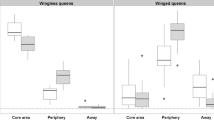Summary
Queen polymorphism in the non-parasitic ant,Leptothorax spec. A, is most probably genetically mediated by a pair of alleles E/e. E suppresses the development of wings, thoracic structures and ocelli in female larvae. Only ee-larvae may grow to gynomorphic, winged queens, EE- and Ee- larvae develop into intermorphic, wingless queens. The frequency of intermorphic queens varies widely in different habitats. Whereas in homogeneous coniferous forests throughout southern and central Quebec the gynomorph is abundant, in patchily distributed rocky outcrops along the St. Lawrence River intermorphic queens predominate. We suggest a different dispersal success of the two morphs in the various habitats.
Zusammenfassung
Der Königinnepolymorphismus der nicht-parasitischen AmeisenartLeptothorax spec. A wird genetisch, wahrscheinlich durch ein Allelpaar E/e, kontrolliert. E unterdrückt dabei in weiblichen Larven die Entwicklung von Flügeln, Ocellen und Thoraxnähten, nur ee-Larven können zu geflügelten, gynomorphen Jungköniginnen heranwachsen. EE-und Ee-Königinnen sind immer intermorph. Die Häufigkeit intermorpher Königinnen im Freiland variiert von Population zu Population: in den homogenen, lichten Nadelwäldern Süd/und Zentralquebecs überwiegt die Gynomorphe, in inselartig beschränkten Biotopen, wie auf den Felsflächen am Lorenzstrom, dominieren intermorphe Weibchen. Unterschiedlicher Erfolg der beiden Morphen in den verschiedenen Biotopen wird angenommen.
Similar content being viewed by others
References
Bolton B., 1986. — Apterous females and shift of dispersal strategy in theMonomorium salomonis-group (Hymenoptera: Formicidae).J. Nat. Hist., 20, 267–272.
Bolton B., 1987. — A review of theSolenopsis genus-group and a revision of AfrotropicalMonomorium Mayr (Hymenoptera: Formicidae).Bull. Br. Mus. Nat. Hist. (Ent.), 54, 263–452.
Brandao C.R.F., 1987. — Queenlessness inMegalomyrmex (Formicidae: Myrmicinae), with a discussion on the effect of the loss of true queens in ants. In: Eder J., Rembold H.,Chemistry and biology of social insects. Verlag J. Peperny, Munich, 111–112.
Brian M.V., 1955. — Studies of caste differentiation inMyrmica rubra L. 2. The growth of workers and intercastes.Insectes Soc., 2, 85–114.
Brown W.L., 1955. — The antLeptothorax muscorum (Nylander) in North America.Ent. News., 66, 43–50.
Buschinger A., 1968. — «Locksterzeln» begattungsbereiter ergatoider Weibchen vonHarpa. goxenus sublaevis Nyl. (Hymenoptera: Formicidae).Experientia, 24, 297.
Buschinger A., 1974. — Experimente und Beobachtungen zur Grüdung und Entwicklung neuer Sozietaten der sklavenhaltenden AmeiseHarpagoxenus sublaevis (Nyl).Insectes Soc., 21, 381–406.
Buschinger A., 1975. — Eine genetische Komponente im Polymorphismus der dulotischen AmeiseHarpagoxenus sublaevis.Naturwissenschaften, 62, 239.
Buschinger A., 1978. — Genetisch bedingte Entstehung geflügelter Weibchen bei der sklavenhaltenden AmeiseHarpagoxenus sublaevis (Nyl.) (Hym., Form.)Insectes Soc., 25, 163–172.
Buschinger A., Alloway T., 1978. — Caste polymorphism inHarpagoxenus canadensis M.R. Smith (Hym., Formicidae).Insectes Soc., 25, 339–350.
Buschinger A., Winter U., 1978. — Echte Arbeiterinnen, fertile Arbeiterinnen und sterile Wirtsweibchen in Völkern der dulotischen AmeiseHarpagoxenus sublaevis (Nyl.), (Hym., Form.).Insectes Soc, 25, 63–78.
Collingwood C.A., 1979. — The Formicidae (Hymenoptera) of Fennoscandia and Denmark.Fauna Entomol. Scand., 8, 174 p.
Davison D.W., 1982. — Sexual selection in harvester ants (Hymenoptera: Formicidae:Pogonomyrmex).Behav. Ecol. Sociobiol., 10, 245–250.
Dubois M., 1986. — A revision of the native new world species of the ant genusMonomorium (minimum-group) (Hymenoptera: Formicidae).Univ. Kans. Sci. Bull., 53, 65–119.
Francoeur A., 1986. — Deux nouvelles fourmis néarctiques:Leptothorax retractus etLeptothorax sphagnicolus (Formicidae, Hymenoptera).Can. Ent., 118, 1151–1164.
Heinze J., 1987. — The application of electrophoretical data on species differentiation in the ant tribe Leptothoracini. In: Eder J., Rembold HChemistry and biology of social insects. Verlag J. Peperny, Muich, 31–32.
Heinze J., Buschinger A., 1987. — Queen polymorphism in a non-parasiticLeptothorax species (Hymenoptera, Formicidae).Insectes Soc., 34, 28–43.
Heinze J., Buschinger A., 1988. — Electrophoretic variability of esterases in the ant tribe Leptothoracini.Biochem. Syst. Ecol., 16, 217–221.
Henze J., Buschinger A., (in press). — Polygyny and functional monogyny inLeptothorax ants (Hymenoptera: Formicidae).Psyche.
Imai H.T., Crozier R.H., Taylor R.W., 1977. — Karyotype evolution in Australian ants.Chromosoma, 59, 341–393.
Kerr W.E., 1950. — Genetic determination of castes in the genusMelipona.Genetic, 35, 143–152.
Kerr W.E., Nielsen R.A., 1966. — Evidences that genetically determinedMelipona queens can become workers.Genetics, 54, 859–866.
Kerr W.E., Stort A.C., Montenegro M.J., 1966. — Importáncia de alguns fatôres ambientais na determinação das castas do géneroMelipona.An. Acd. Bras. Ciên., 38, 149–168.
Plateaux L., 1970. — Sur le polymorphisme social de la fourmiLetothorax nylanderi Förster. 1. Morphologie et biologie comparées des castes.Insectes Soc., 12, 373–478.
Rosengren R., Pamilo P., 1983. — The evolution of polygyny and polydomy in moundbuildingFormica ants.Acta Entomol. Fennica, 42, 65–77.
Tulloch G.S., 1930. — Thoracic modifications, accompanying the development of subaptery and aptery in the genusMonomorium.Psyche, 37, 202–206.
Wilson E.O., 1971. — The insect societies.Belknap Press of Harvard University Press, Cambridge, MA, 548 p.
Winter U., Buschinger A., 1986. — Genetically mediated queen polymorphism and caste determination in the slave making ant,Harpagoxenus sublaevis (Hymenoptera: Formicidae).Entomol. Gener., 11, 125–137.
Author information
Authors and Affiliations
Rights and permissions
About this article
Cite this article
Heine, J., Buschinger, A. Queen polymorphism inLeptothorax spec. A: Its genetic and ecological background (Hymenoptera: Formicidae). Ins. Soc 36, 139–155 (1989). https://doi.org/10.1007/BF02225909
Received:
Accepted:
Issue Date:
DOI: https://doi.org/10.1007/BF02225909




